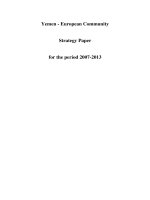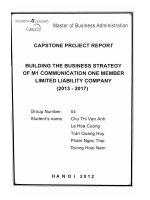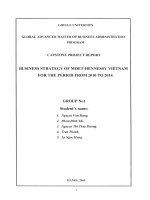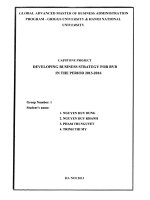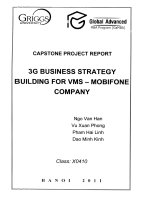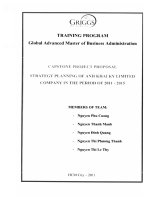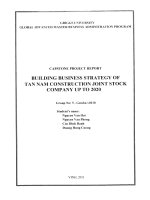Business strategy formation for Saigon purified water limited company (Sapuwa) for the period 2013 to 2018
Bạn đang xem bản rút gọn của tài liệu. Xem và tải ngay bản đầy đủ của tài liệu tại đây (2.12 MB, 109 trang )
Business strategy formation for SaiGon purified water limited company for 2013 - 2018
CAPSTONE PROJECT REPORT
BUSINESS STRATEGY FORMATION FOR SAIGON
PURIFIED WATER LIMITED COMPANY (SAPUWA)
FOR THE PERIOD 2013 TO 2018.
Group No.01
LUONG THI MINH THUY(Leader)
PHAN THI KIEU GIANG
TRAN VAN BINH
DO VAN NGHIA
Class: GaMBA01.C0311
Ho Chi Minh City, 2013
Business strategy formation for SaiGon purified water limited company for 2013 - 2018
GRIGGS UNIVERSITY
GLOBAL ADVANCED MASTER
OF BUSINESS ADMINISTRATION PROGRAM
CAPSTONE PROJECT REPORT
BUSINESS STRATEGY FORMATION FOR SAIGON
PURIFIED WATER LIMITED COMPANY (SAPUWA)
FOR THE PERIOD 2013 TO 2018
Group No.01
1. LUONG THI MINH THUY(Leader)
2. PHAN THI KIEU GIANG
3. TRAN VAN BINH
4. DO VAN NGHIA
Class: GaMBA01.C0311
Ho Chi Minh City, 2013
Business strategy formation for SaiGon purified water limited company for 2013 - 2018
THANKS
Firstly, we’d like to thanks The Board of Directors of Center for Educational
Technology and Career Development – Vietnam National University, Hanoiand Griggs
University,USA, has provided education in Vietnam with conditions for us to to study
and complete Global Advanced Master Of Business Administration Program.
We’d like to thank sincerely and profoundly to the lecturers who teach
enthusiastically, wholeheartedly to impart knowledge and enthusiastically guide our
group to complete this capstone project report, enabling us to complete this course
as well.
Our group would like to give the deep thank our colleagues, the Director
Board of SAPUWA company, class management board and GaMBA01.C0311
class’s members have helped, encouraged and supported for our group to complete
well the study program and this capstone project report .
Ho Chi Minh City, April 2013
Group 1 – C0311
Business strategy formation for SaiGon purified water limited company for 2013 - 2018
TABLE OF CONTENT
INTRODUCTION 1
1.The purpose of the research 1
2. The targets of the research 1
3. Research areas 2
4. Research methodology and data source 2
4.1 Research method 2
4.2 Data source 2
5. The aims of the research 3
6. Structure of the research 3
CHAPTER 1: THEORIES ON BUSINESS STRATEGIES FORMATION 4
1.1. Definition of a strategy 4
1.2. Roles of a strategy 4
1.3. Classification of strategy 5
1.3.1. Classification by management involvement 5
1.3.2. Strategies classification on functions 6
1.4. Strategies management process 6
1.5. Business strategy formation methodology 8
1.5.1 Vision, mission, strategic goals of a company 8
1.5.2. External environment analysis 8
1.5.3. Internal environment 11
1.5.3.1 Human resource 11
1.5.3.2 Financial ability 11
1.5.3.3 Marketing and selling operations 12
1.5.3.4. Management activities 12
1.5.3.5. Technology: 13
1.6. Toolkit for strategy formulation 13
1.6.1. External factor evaluation matrix (EFE Matrix) 13
1.6.2. Internal factor evaluation matrix (IFE Matrix) 14
Business strategy formation for SaiGon purified water limited company for 2013 - 2018
1.6.3. Competitive picture matrix (CPM) 14
1.6.4. SWOT matrix 15
1.6.5. QSPM (Quantitative Strategic Planning Matrix) 16
SUMMARY OF CHAPTER 1 18
CHAPTER 2: ANALYSIS AND ASSESSMENT BUSINESS PERFORMANCE AND
ENVIRONMENT OF SAIGON PURIFIED WATER CO., LTD. (SAPUWA) 19
2.1 Background Information of SAIGON PURE WATER Ltd. Company (SAPUWA) 19
2.1.1 History and Development 19
2.1.2 Business Philosophy of SAPUWA: 4 “Cleans” 20
2.1.3 Slogan of SAPUWA : “The Endless Purity” 20
2.1.4 Organization of SAPUWA 20
2.1.5 Market and Market Share of SAPUWA 22
2.1.5.1 Market 22
2.1.5.2 Market Share 22
2.1.6 Business Results of SAPUWA in 3 years (2010-2012) 22
2.2 Environmental Factors Affected SAPUWA’s Business Operation 24
2.2.1 Analysis of External Environment 24
2.2.1.1 Macro Environment 24
2.2.1.2 Micro Environment 26
2.2.1.3 External Factor Evaluation Matrix 28
2.2.1.4. Competitive Profile Matrix (CPM) 30
2.2.2 Analysis of Internal Environment 31
2.2.2.1 Structure, Organization Chart and Management Board of SAPUWA 31
2.2.2.2 Human Resources 31
2.2.2.3 Financial Capacity 31
2.2.2.4. Workshop, Machinery and Technology 38
2.2.2.5. Manufacturing Process of SAPUWA’s Bottled Water (Appendix VI) 39
2.2.2.6. Information System 39
2.2.2.7. Intellectual Property and Copyright 39
Business strategy formation for SaiGon purified water limited company for 2013 - 2018
2.2.2.8. Possibility in Research and Product Development 39
2.2.2.9 Marketing 39
2.2.2.10. Internal Factor Evaluation Matrix (IFE) 49
2.2.3 SWOT of SAPUWA 51
SUMMARY OF CHAPTER 2 52
CHAPTER 3: BUSINESS STRATEGIC PLAN FOR SAIGON PURIFED WATER Ltd.
COMPANY BY 2018 53
3.1 Mission, Orientation and Development Objectives of SAPUWA by 2018. 53
3.1.1 Mission 53
3.1.2 Orientation 53
3.1.3 The developmental goals of Sapuwa by 2018 54
3.2 Formulating and Selecting Business Strategies For SAPUWA by 2018 55
3.2.1 Formulating Strategies For SWOT Matrix Analysis 55
3.2.2 Selecting Strategies via QSPM matrix 60
3.3 Recommendation of Business Strategy For SAPUWA by 2018 65
3.3.1 Solutions for Finance and Accounting 65
3.3.2 Solutions for Management 65
3.3.3 Solutions for Human Resource 65
3.3.5 Solutions for Organization 66
3.3.5.1 Mission of Marketing Division 66
3.3.5.2 Mission of Marketing Division’s Departments 67
3.3.6 Solutions for Market and Market Research Organization 68
3.3.6.1 Solutions for Marketing 68
3.3.6.2 Market Research Organization 68
3.3.7. Building, Consolidating and Developing Customers Relationship 69
3.3.8. Completing Customers’ Complaint-Taking Service 70
3.4. Recommendations 70
3.4.1 Recommendation for Government 70
3.4.2 Recommendation for SAPUWA 71
Business strategy formation for SaiGon purified water limited company for 2013 - 2018
SUMMARY OF CHAPTER 3 71
CONCLUSION 72
REFERENCES 73
LIST OF APPENDIX i
Business strategy formation for SaiGon purified water limited company for 2013 - 2018
LIST OF TABLE AND FIGURE
Table 1-1 : Model of global strategic management
Table 1-2 : 5 Forces of M.Porter
Table 1-3 : External Environment Matrix – EFE
Table 1-4 : Infernal Environment Matrix – IFE
Table 1-5 : CPM matrix
Table 1-6 : SWOT matrix
Table 1-7 : QSPM matrix
Table 2.1 : Financial annual report of SAPUWA from 2010 to 2012
Table 2.2 : Customers Development through the years (2008 – 2012)
Table 2.3 : External Factors Evaluation Matrix
Table 2.4 : Competitive Profile Matrix
Table 2.5 : Basic Financial Targets in the last 3 years (2010-2012)
Table 2.6 : Financial targets
Table 2.7 : Product Parttern of Consumption in 2010 - 2012
Table 2.8 : SAPUWA’s Price List
Table 2.9 : Price List of Accompanying Products
Table 2.10 : EX Works (EXW) of same products of competitors
Table 2.11 : Distributing Channels of SAPUWA
Table 2.12 : Internal Factor Evaluation Matrix.
Table 2.13 : SWOT Analysis of SAPUWA
Table 3.1 : The SWOT Matrix of SAPUWA
Table 3.2 : QSPM Matrix for the group S-O
Table 3.3 : The QSPM Matrix for the group S-T
Table 3.4 : The Marketing Division
Business strategy formation for SaiGon purified water limited company for 2013 - 2018
ABBREVIATION LIST
Ltd. : Limited
EPI : Earth Policy Institute
GDP : Gross Domestic Product
Sol : Solution
Gal. : Gallon
PQC : Product Quality Control
L. : Litter
MW : Mineral Water
BW : Bottled Water
M-BW : Mineral and Bottled Water
CMW : Carbonated Mineral Water
NCMW : Non-Carbonated Mineral Water
PC : Polycarbonate
PET : Polyethylene Terephthalate
WBS : Wine, Beer and Soft Drink
HCMC : Ho Chi Minh City
VS : Vietnamese Standards
USD : United State Dollar
VND : Vietnam Dong
FHS : Food Hygiene and Safety
WTO : World Trade Organization
Business strategy formation for SaiGon purified water limited company for 2013 - 2018
page 1 of 73
INTRODUCTION
1.The purpose of the research
Vietnam market of bottled mineral and drinking water has enjoyed exciting
growth, with average annual growth of 26%, and stood at 22% of the total beverage
market. The attractiveness of the market has drawn interest and participation of various
economic forces, both domestic and international, which drove the market to a fiercer
competition. (Source: AC Nielsen)
Being one of the leaders in Vietnam bottled drinking water industry, Saigon Purified
Water Company Limited (SAPUWA) has been a major player in the Vietnam market for
bottled mineral and drinking water since 1992, and has gained various significant
encouraging achievements. However, as the market has turned to be very fierce competitive
environment, and as a response to the strong move of global integration, SAPUWA is forced
to face the business environment with continuous changing, more sophisticated with more
unforeseen risk factors. In response to the escalating competitive pressure, in order to sustain
and grow, Vietnam businesses in general and Saigon Purified Water Company Limited
(SAPUWA) in particular are required to form their own suitable, appropriate and efficient
business strategies.
As required by the need found from the current market situation, and with the
desire to contribute to the development of a business in the bottled mineral and drinking
water industry, the Group One selected to conduct a research on the theme: “Business
Strategy Formation for Saigon Purified Water Company Limited (Sapuwa) for the
period 2013 to 2018”.
2. The targets of the research
The primary targets of this research include to figure out the market position of
SAPUWA products, with special attention driven on analyzing and assessing the impacts
to the company’s business performance of different business factors of both internal and
external environments, from which, to define the company’s strengths weaknesses,
opportunities and threats. Further, basing on findings, the Group One will form a set of
business strategies for SAPUWA for the period of 2013 – 2018 with solutions proposed
to efficiently implement those business strategies discussed to assure the highest
business performance of the company.
Business strategy formation for SaiGon purified water limited company for 2013 - 2018
page 2 of 73
3. Research areas
Geographical areas of the research: the research is focused to the market of
bottled mineral and drinking water in Ho Chi Minh City areas, and is within the
boundary of studying the operation of SAPUWA in Ho Chi Minh City.
Time span of the research: historical and projection data employed in this research
is for the period of 2010 – 2018.
4. Research methodology and data source
4.1 Research method
There are some research methods such as synthesis, analysis methods the amounts
of Sapuwa in the past and present as well as comparison targets, business performance
metrics of Sapuwa with other competitors in bottled mineral and drinking water industry.
In addition, research also consults of experts Sapuwa on the assessment and
classification scores of attractions in the process of analyzing matrix QSPM.
4.2 Data source
Information collected is of primary and secondary sources.
Primary information: collected from site surveys on pricings, brandings,
packaging designs, presentations, qualities of products on circulation at supermarkets,
retailer shops, distribution agencies and so forth in Ho Chi Minh City and Ha Noi. Our
survey team also conducted direct interviews with 400 consumers in HCMC and Ha Noi
( HCMC: 250 people, Ha noi: 150 people) with a set of designed questionnaire to
evaluate consumers’ perception, preferences, tastes, consuming and buying habits in
conditions of today’s life and in the future. Data collected are screened, adjusted, filtered
and treated on SPSS to support our analysis.
Secondary information: in our research, we also employed data of various official
secondary sources from Statistic Bureau, Tourist Board, Ministry of Planning and
Investment, Vietnam Alcohol and Beverage Corporation, survey data and reports of
market research agencies and consultants, reports, presentations and data of site surveys
by other companies in the industry, and other sources in the internet.
Business strategy formation for SaiGon purified water limited company for 2013 - 2018
page 3 of 73
5. The aims of the research
The aims of the research are essentially practical in assisting SAPUWA an
overview for its growth path in the future (period of 2013 – 2018), an understanding on
market information precisely, which allow the company to take and maximize
opportunities when they come, while minimize the risks exposed, to gain the best
performance. On another hand, the research results are also helpful reference resources
for other businesses operating in the industry of bottled mineral and drinking water
having their products sold in the areas of Ho Chi Minh City in defining their business
strategies.
6. Structure of the research
Other than the Forewords, Reference, Appendixes, the research is composed into
three chapters as detailed below:
CHAPTER 1: THEORIES ON BUSINESS STRATEGIES FORMATION.
CHAPTER 2: ANALYSIS AND ASSESSMENT BUSINESS PERFORMANCE AND
ENVIRONMENT OF SAIGON PURIFIED WATER CO., LTD.
(SAPUWA)
CHAPTER 3: BUSINESS STRATEGIES FORMATION FOR SAIGON PURIFIED
WATER CO., LTD. TILL 2018
Business strategy formation for SaiGon purified water limited company for 2013 - 2018
page 4 of 73
CHAPTER 1
THEORIES ON BUSINESS STRATEGIES FORMATION
1.1. Definition of a strategy
A strategy is a general action plan to reach a particular goal. When addressing a
strategy of an organization, we think about how the organization defines goals, how to
reach the goals, and how to assure resources to reach these goals.
Alfred Chandler's definition: "determination of the basic long-term goals and
objectives of an enterprise, and the adoption of courses of action and the allocation of
resources necessary for carrying out these goals."
Ferd R, David stated in “Strategy management concept”: a strategy is a set of
means to reach long-term goals. Business strategies may include geographical expansion,
diversification of operation, ownership, product development, market penetration, cost
cutting, liquidation and joint venture.
A strategy may be seen as a set of goals, plans and policies in order to achieve the
goals, and explaining a business is conducting what business activities, and a business is
or will be in operation in what industry of sector.
1.2. Roles of a strategy
Roles in planning: a business strategy helps a business to define goals and
courses of actions to reach the goals. It shows to a business management to consider and
define a path on which the business will follow and when the goals are reached with
expected results.
Roles in forecasting: in a continuous changing environment, there come always
opportunities and threats. Strategy planning helps management in analyzing the business
environment and forecasting and setting appropriate actions. Therefore, management can
better seize opportunities and minimize risks exposed in a particular environment.
Roles in controlling: a business strategy helps management utilize and allocate
resources available in the best match, as well as synchronize efficiently functional areas
within the organization with the aim to reach the set goals.
Business strategy formation for SaiGon purified water limited company for 2013 - 2018
page 5 of 73
1.3. Classification of strategy
1.3.1. Classification by management involvement
By the management involvement, strategies are classified into three groups as follow:
Corporate strategies: are strategies clearly define goals and targets of a company,
business activities for which a company strive, make policies and basic plans to reach the
goals, allocate resources among different business functional areas. Corporate strategies
are applied for the entire business.
Business strategies: are strategies that are formed to define what products or what
market segments for a business operation within a company. In business strategies,
specific plans are defined for each business unit upon completion of which, the unit
contributes to completion of company overall goals.
Functional area strategies: competitive advantages come from capability in
reaching an outstanding efficiency, quality, innovation, and responsibility to customers.
Functional area strategies have focus on roles and ways to improve efficiency of each
operational unit within a company, such as marketing, raw material management,
product development, production management, customer service.
On the strong move of globalization, competition has become fiercer. On another
hand, to cope with two sources of pressure on competition and cost reduction while
maintain market expansion, more and more companies want to enter into international
market competition, which bring the level 4th strategies: global strategies.
To enter and compete in a global environment, companies can employ four basic
strategies as following:
- Multidomestic strategies,
- International strategies,
- Global strategies,
- Transnational strategies.
Business strategy formation for SaiGon purified water limited company for 2013 - 2018
page 6 of 73
1.3.2. Strategies classification on functions
Integration strategies group:
- Forward integration,
- Backward integration,
- Horizontal integration.
Depth penetration strategies group:
- Market Penetration,
- Market Development,
- Product Development.
Operational diversification strategies group:
- Concentric diversification,
- Horizontal diversification,
- Conglomerate diversification.
Other strategies group:
- Joint Venture,
- Retrenchment,
- Divestiture,
- Liquidation,
- Mixed strategies.
1.4. Strategies management process
Strategies management process includes three main closely related and
complementing stages:
Strategy planning stage: is the first stage forming the foundation and playing an
important role in overall strategy management process. It is necessary to define vision,
mission statement and strategic goals of the organization in this stage. At this stage, business
strategies, industries in which a company does business and so forth are clearly defined. At
this stage, company focuses on analyzing factors of internal and external environments,
precisely defines opportunities, threats, strengths, and weaknesses, which all help to form
appropriate strategies. Strategy formation stage is composed of three basic activities:
conducting studies, combining observation and analysis, and decision making.
Business strategy formation for SaiGon purified water limited company for 2013 - 2018
page 7 of 73
Strategy implementing stage: is the stage in which strategy is transformed into actions
to achieve defined goals. This stage is important in overall strategy management process,
because if a strategy is finely and scientifically defined in the first stage will become
nonsense if it is not appropriately implemented. This stage requires mobilizing all the
company resources to implement the defined strategies. Strategy implementing stage is
composed of three basic activities: annual target setting; policy making; and resources
allocating.
Strategy assessing stage: is the final stage of the strategy management process. The
stage include activities such as results evaluation, results monitoring, solutions sought to
adjust defined strategy to changing environment. Monitoring strategy implementation in
every stage, timely reviewing of appropriateness of the strategy to adjust to condition faced,
or predicting events that may arise having influence on the implementation of the strategy,
which help a company to adjust its planning in the future to seize opportunities, cope with
challenges, or event turn challenges into opportunities. Monitoring works are carried
regularly, continuously, which include activities as follow: monitoring factors which cores
for the current strategy; measuring achievements; conducting adjustments.
Allocation of
resources
Redetermining the
business target
Analysis of internal
factor. Identifying
strengths,
weaknesses
Selection of
strategies to
be performed
Bringing
forward the
policies
Table 1-1: Model of global strategic management
From: Fred F.David, Concepts of Strategy, p.27
Strategy planning Strategy performance evaluation
Determi-ning
the vision,
the mission,
the strategic
target
Analysis of external
factors,
determination of
opportunities & risks
Measure-
ment and
evaluation of
the strategic
performan-
ce
Long term
target setting
up
Annual target
setting up
Business strategy formation for SaiGon purified water limited company for 2013 - 2018
page 8 of 73
1.5. Business strategy formation methodology
1.5.1 Vision, mission, strategic goals of a company
The first step of a strategy management process is to define mission and strategic
goals of an organization. Mission and strategic goals of an organization form the
circumstance in which strategies are formulated.
A mission states “the reasons for being” of an organization, and tells what the
organization is doing. For instance, mission statement of national airlines is “able to meet
high-speed transportation demand of passengers at reasonable prices.”
Strategic goals are to specify what an organization expects to do in middle to long
term. Most organizations specify missions for profit, outstanding capability to gain the first
leading place. Other secondary missions are stated to express what a company consider
necessary to be outstanding.
1.5.2. External environment analysis
External environment includes macro and micro environments.
1.5.2.1. Macro environment – pest (or also so called general environment)
Economic factors: having direct influence on the potential attractiveness of different
strategies are different. Influential economic factors include economic growth, inflation,
economic cycles, banking interest movements, stock price fluctuation, foreign exchange,
taxation and so forth.
Political and legal factors: having increasing influence on a business operation. In the
legal aspect, factors such as political trend, policies, laws and regulations, remunerations,
administrative procedures, administrative institutions. In some countries, it is necessary to
consider the political stability and or sustainability of the government. Laws, regulations,
and state administrative institutions together with pressuring forces are having influence on
a business operation.
Social and cultural factors: a business has to have a thorough analysis of social
factors to define its potential opportunities. Some of social factors to consider include roles
of women in the society, anthropological and demographic matters, population changes, life
style, moral values, traditions, habits, local practice, education background and so forth.
Changes in geographic, demographic, cultural and social conditions are having significant
influence to almost all decisions on products, services, market segments, and consumers of a
business.
Business strategy formation for SaiGon purified water limited company for 2013 - 2018
page 9 of 73
Demographic factors: The size of population influences significantly to almost all
products, services, market size, and consumers. Those businesses with many years in the
market are experienced in incorporating impacts of the surrounding natural condition
into their decision making process. The major factors include the size of population, age
structure, geographic location, ethnic diversification, income disparity, pollution, energy
shortage, wasteful exploration of natural resources, and increasing need of natural
resources.
Technology factors: to a business, technology factors such as R&D, patency,
automation trend, technology transfer… are both opportunities and challenges, and these
factors have to have adequate consideration when formulating a strategy. The sooner a
technology is developed, the shorter a product life. New technologies bring in life new
technological process which allows significant cost cutting in production cost. With the
pace of technology development, new technology is more competitive than those
currently available.
Globalization factors: globalization, economic integration, and economic
liberation are today’s matters of the world economy. Laws and regulations of European
Union, the World Bank, the World Trade Organization (WTO), regional and
international free trade agreements, world summits on economic issues … enhanced
cross dependency of nations in the world, and global common markets are formed,
which require common sets of standards of quality, environmental pollution, monopoly
limitation laws, laws on dumping price …Strategy makers are required to consider to
maximize the benefits of globalization and world economic integration, while at the
same time mitigate the risks of international market, which is fiercer competition with
foreign competitors, whose products are more price and quality competitive.
1.5.2.2. Micro environment analysis (or so called industry environment/competition
with an industry)
In the theory of 5 competitive forces by Michael Porter
Michael Porter (Harvard Business School) proposed the theory of 5 competitive
forces within an industry as follow:
Business strategy formation for SaiGon purified water limited company for 2013 - 2018
page 10 of 73
Table 1-2: 5 Forces of M.Porter
Potential entrants: include companies newly enter into the industry, whose current
competitive power weak, but will be competitive in the future. New entries may weaken
the profitability of a business, since they bring in newly added production capacity, with
the aim to gain desired market share and necessary resources. Therefore, when
formulating a business strategy, management should consider from the threats from new
entries.
Existing competitors: The second competitive forces in Michael Porter model are
those of the same industry, having been in solid positions in the market. The fiercer is
the competitiveness, the lower the price, which leads to a lower profitability. There are
three key factors influencing intensity of the competition among competitors in an
industry: competitive structure, demand for the subject product in the market, and exit
barrier. An important part of external environment management is to identify all
competitors with full understanding of strengths, weaknesses, capabilities, opportunities,
threats, targets, and strategies of each of them.
Customers: The third force in Michael Porter model of competitive forces is the
bargaining power of the customers. Customers always bargain for lower prices, better
qualities, or more inclusive services. These all lead to high operating costs and bring
more threats on pricing competition.
Business strategy formation for SaiGon purified water limited company for 2013 - 2018
page 11 of 73
Suppliers: The fourth force in the model is the bargaining power of suppliers to a
business. Suppliers include not only those who supply raw materials, equipment and
machineries, labor force, but also consultancy companies, advertisement agencies,
logistic service providers and so forth, who, in a general word, supply inputs to a
manufacturing process. In order to lessen the bargaining power or pressure from the
suppliers, a business should establish a mutual benefit sharing relation, along with effort
in diversifying supplying sources.
Substitutes: The final force in the five forces in Michael Porter competitive model
is substitute products. Substitute products are products of competitors in the same
industry or products of other industries meeting the need or similar needs of customers.
In order to minimize pressure from this threat, the management should carefully examine
pricing trend and other forecasts of substitute products.
Besides evaluating of the five competitive forces in Michael Porter as
abovementioned, during external environment analysis, the management should pay
adequate attention to other factors such as distributors, community, labor union, and the
so forth to define opportunities and threats in the company business operation.
1.5.3. Internal environment
1.5.3.1 Human resource
Human resource is the most important resource of an organization. Human
resources management activities are generally understood to include recruitment,
placement, training, and allocating human resource. The aim of a human resource
strategy is to develop a plan for human resource to meet strategic needs of a company,
both in long term and short term.
1.5.3.2 Financial ability
Financial condition is often seen as methods to evaluate the best competitive
position of the company and is the most attractive conditions for investors. To form
effective strategies to identify the financial strengths and weaknesses of the organization.
Financial factors often change the current strategy and the implementation plan. The
financial functions including: The ability to raise capital; Financial Risk Management;
earning ability.
Business strategy formation for SaiGon purified water limited company for 2013 - 2018
page 12 of 73
1.5.3.3 Marketing and selling operations
Marketing and selling operations: activities of this type are of four major issues:
products, pricing, supports, and distribution channels. They include activities such as
customers analysis, product/service planning, price policy, distribution policy, market
research, advertisement and promotion activities, dealers and distributors and retailers
support activities, and other activities by sales force.
1.5.3.4. Management activities
There are 5 major management activities, as follow:
Planning activities include all activities in preparation for the future. The specific
tasks include predicting, setting goals, building strategies, and developing policies.
Personnel planning activities includes all activities to create a structure in which
clear definitions, rights and responsibilities of each position and relationships between
one to another are established. The specific tasks include designing specific reporting
structure, providing detailed job analysis and job descriptions, installing efficient internal
information transmission system which can generate timely.
Motivation activities include efforts to provide guidance for all personnel position
to perform to generate a desired outputs; in a more specific way that management and
team leaders consider to improve or change the operational hierarchy, authorize and
delegate power to stimulate higher quality performance and higher job engagement while
maintaining positive feeling in all staff force.
Human resource activities have a special focus on personnel and human resource,
from recruitment, payroll and remuneration scheme, labor safety, equal
employment opportunities, relations with labor unions, labor policies, inquiry or
petition procedures, and other public relations activities.
Control activities are those activities to ensure that the actual business results are
consistent with business plan, and include quality control, financial control, sales
monitoring, inventory control, reception and analysis of the market changes.
Business strategy formation for SaiGon purified water limited company for 2013 - 2018
page 13 of 73
1.5.3.5. Technology:
Includes activities related to research and product development / production
processes, process improvements, required machinery and equipment, design software
development and so forth.
Further, in order to be able to assess fully and accurately the internal environment
of a business, we should also consider other five factors: financial analysis (cash-flow,
leverage position, operational profit and sales growth), culture, leadership, legitimacy
and reputation of the business.
1.6. Toolkit for strategy formulation
1.6.1. External factor evaluation matrix (EFE Matrix)
Forming a matrix for external factor evaluation will help us in summarizing and
quantifying influences of external factors to operation of a business, and help
management project a roadmap to respond to each opportunity or challenge, deliver a
judgment of external environment if favorable or unfavorable to a business.
In order to form the matrix, we list all external factors having influence to a
business’s operation; evaluating importance of each factor by giving each a weigh, with
total weight of all factors equals 1. The classification shows a relative importance of
each factor to the success of a company in the industry.
Classification of each factor importance is to rate the factor in the scale of 1 to 4.
In which, level 4 is the level that a company has best responsiveness; level 3 is above
average; level 2 is average, and level 1 is the lowest. These levels are based on the
effectiveness of a company’s strategies. The following steps to determine the weight of
each factor importance by multiplying the importance index with the relevant
classification. After that, summing up of all importance points of each factor to arrive a
total importance point of a company, with highest level is 4 and lowest level is 1, and an
average 2,5 point.
If the total importance point is 4, it is to express that the company has been best
maximizing external opportunities and well controlling or minimizing external threats to
the company. If the total importance point is 1, it is to say the company has not taken
opportunity and has not minimized the threats from external environment.
Business strategy formation for SaiGon purified water limited company for 2013 - 2018
page 14 of 73
External Factors
Evaluate level
Point
Score
List all factors
…
…
…
Summary
…
…
…
Table 1-3: External Environment Matrix – EFE
1.6.2. Internal factor evaluation matrix (IFE Matrix)
The construction of internal factors matrix elements will help us to summarize,
evaluate the strengths and weaknesses of the important functions of the business. It
affects the business activities of enterprises. Similar to external environment matrix, we
conduct a similar evaluation:
Internal Factors
Evaluate level
Point
Score
List all factors
…
…
…
Summary
…
…
…
Table 1-4: Infernal Environnent Matrix – IFE
1.6.3. Competitive picture matrix (CPM)
Competition profile matrix compares the company with main competitors, based
on the factors affecting the competitiveness of the companies in the industry.
Competition profile matrix help managers identify the main competitors, their
advantages and disadvantages, and evaluate the company's advantages and disadvantages
in comparison. Competition profile matrix is an extension of the EFE matrix in respect
of importance factors, classification system and the total number of critical points.
However, unlike EFE matrix, managers can put into this matrix the major elements of
the internal environment factors that influence on the development of businesses such as
financial stability, the effectiveness of marketing activities, and appropriate investment
for R&D activities
Business strategy formation for SaiGon purified water limited company for 2013 - 2018
page 15 of 73
KFS
Criteria
The company
Competitor 1
Competitor 2
Rating
Score
Rating
Score
Rating
Score
List all factors
Total
Table 1-5: CPM matrix
1.6.4. SWOT matrix
SWOT Matrix is the most essential, effective, and popular common tool helping
management in formulating four groups of strategies as follow:
Strengths-Opportunities strategy (SO)
Weaknesses-Opportunities strategy (WO)
Strengths-Threats strategy (ST)
Weaknesses-Threats strategy (WT)
A chart presenting SWOT matrix is composed of 9 cells with 4 cells containing
important factors (S, W, O, T), 4 cells of strategies (SO, ST, WO, WT), 1 cell always
empty is the top left.
O – Opportunity
- List all opportunities.
(3)
T – Threaten
- List all threats.
(4)
S – Strong
List all strengths.
(1)
SO strategies
- employ strengths to
maximize opportunities.
(1+3)
ST strategies
- cross challenges employing
strengths.
(1+4)
W - Weak
- List all weaknesses
(2)
WO strategies
- minimize the weaknesses
to seize the opportunities.
(2+3)
WT strategies
- minimize weaknesses to
mitigate the threats.
(2+4)
Table 1-6: SWOT matrix
Business strategy formation for SaiGon purified water limited company for 2013 - 2018
page 16 of 73
1.6.5. QSPM (Quantitative Strategic Planning Matrix)
After employing SWOT matrix to formulate appropriate strategies, management
will list all feasible strategies that the company can implement in the near future. At this
stage, a tool helping to select strategies is Quantitative Strategic Planning Matrix –
QSPM.
QSPM employs inputs resulted in analysis forming IFE and EFE matrixes to aid
strategy makers in objective decision making. A strategy among strategies which has
highest interchangeability is the most attractive one and worth for the company to
implement to reach the set goals. A process to formulate a QSPM composes six steps:
Step 1: List all significant external opportunities/threats and significant internal
opportunities/threats into the column (1) of the matrix. These factors are imported
directly from EFE and IFE matrixes.
Step 2: In the column (2) of the matrix, fill the relevant figures of each factor in the
classification columns from EFE and IFE matrixes.
Step 3: Study SWOT matrix and define interchangeable strategies worth
consideration to implement, write these strategies into top row of QSPM. Strategies are
placed into different groups (if any).
Step 4: Determining the attractiveness point: very least attractive = 1, less
attractive = 2, attractive = 3, fairly attractive = 3, very attractive = 4. The values tell us
about relative attractiveness of each strategy to others of the same group of
interchangeable strategies.
Step 5: Calculate the attractiveness point of each strategy considering each
important success factor as listed in the column (1) by multiplying classification point to
attractiveness point within a row.
Step 6: Sum all attractiveness points to arrive a total attractiveness point of each
strategy (with consideration to all relevant internal and external environments having
influence to strategic decisions). The higher the total sum point, the higher the
appropriateness of the strategy and worth selection.

